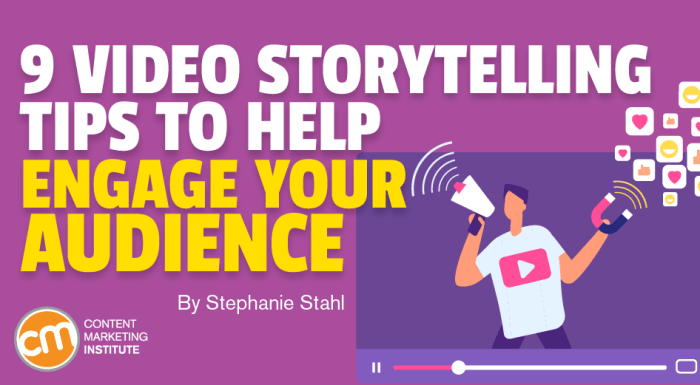Using Video Content for Storytelling kicks off the discussion on captivating audiences through compelling visual narratives, diving into the world of video storytelling with a fresh perspective.
Exploring the power of videos in conveying impactful stories and connecting with viewers on a deeper level, this topic delves into the art of storytelling through a visual medium.
Introduction to Using Video Content for Storytelling
Video content for storytelling involves using videos to convey narratives, messages, or information in a visual and engaging way. It adds a dynamic element to traditional storytelling by combining visuals, audio, and sometimes text to create a more impactful and memorable experience for the audience.
Incorporating videos in storytelling is essential in today’s digital age, where attention spans are shorter, and visual content is more engaging than plain text. Videos can evoke emotions, capture attention, and bring stories to life in ways that written words alone cannot. They allow storytellers to connect with their audience on a deeper level and create a more immersive experience.
Examples of Successful Storytelling through Video Content
- One powerful example of successful storytelling through video content is the Dove Real Beauty Campaign. Through a series of videos, Dove challenged beauty standards and promoted self-acceptance, sparking conversations and resonating with audiences worldwide.
- Another notable example is the “Like a Girl” campaign by Always, which used video content to challenge stereotypes and empower young girls. The campaign went viral, reaching millions of viewers and changing perceptions about what it means to do something “like a girl.”
- The ALS Ice Bucket Challenge is a prime example of how video content can drive social change and raise awareness. The challenge involved participants filming themselves pouring ice-cold water over their heads to support ALS research, leading to a viral sensation and significant donations to the cause.
Types of Video Content for Storytelling
When it comes to storytelling through video content, there are various types that brands and creators can utilize to convey their narratives effectively. Each type of video content brings a unique flavor to the storytelling experience, allowing for diverse ways to engage with the audience and deliver a compelling message.
Animation
Animation is a popular choice for storytelling as it offers endless possibilities for creativity and imagination. Through animated videos, brands can bring characters and worlds to life in ways that may not be possible with live-action. Animation allows for the depiction of fantastical scenarios, abstract concepts, and visually stunning visuals that captivate viewers. For example, companies like Pixar and Disney are known for their use of animation to tell heartwarming stories that resonate with audiences of all ages.
Live-Action
Live-action videos, on the other hand, provide a sense of realism and authenticity that can connect with viewers on a more personal level. By featuring real people, settings, and events, live-action videos create a sense of immediacy and relatability that draws audiences in. Brands like Nike and Coca-Cola often use live-action storytelling to showcase real-life experiences, emotions, and interactions that resonate with their target audience.
Interviews
Interviews are another powerful tool for storytelling through video content, allowing brands to highlight the voices and perspectives of real individuals. By featuring interviews with employees, customers, or industry experts, brands can add credibility and authenticity to their narratives. Interview videos provide a behind-the-scenes look at the people behind the brand, creating a sense of transparency and trust with the audience. Companies like Patagonia and TOMS Shoes often use interview-style videos to share the stories and values that drive their mission-driven businesses.
Elements of Compelling Video Storytelling
When it comes to creating engaging video content for storytelling, there are key elements that can make a significant impact on the audience. The combination of visuals, sound, and narrative plays a crucial role in capturing the viewers’ attention and emotions, ultimately leading to a compelling story that resonates with the audience.
Role of Visuals
Visuals are a powerful tool in video storytelling, as they help to convey emotions, set the mood, and create a visually appealing experience for the audience. High-quality visuals, such as well-shot footage, stunning graphics, and captivating animations, can enhance the storytelling process and make the story more engaging and memorable.
Role of Sound
Sound is another essential element in video storytelling, as it can evoke emotions, create suspense, and enhance the overall viewing experience. The use of background music, sound effects, and voiceovers can help to set the tone of the story and guide the audience through the narrative, making it more impactful and immersive.
Role of Narrative
Narrative is the backbone of any compelling video story, as it provides structure, context, and meaning to the content. A well-crafted narrative with a clear beginning, middle, and end can keep the audience engaged and invested in the story, while also delivering a powerful message or moral that resonates with the viewers.
Tips for Integrating Emotional Elements
To effectively integrate emotional elements into video storytelling, consider the following tips:
- Use authentic and relatable characters to connect with the audience on a personal level.
- Create a compelling storyline that elicits strong emotions such as joy, sadness, excitement, or empathy.
- Utilize music, sound effects, and visuals to enhance the emotional impact of key moments in the story.
- Show vulnerability and authenticity to create a genuine emotional connection with the audience.
- Focus on storytelling techniques such as foreshadowing, suspense, and dramatic tension to keep the audience emotionally engaged throughout the video.
Platforms for Sharing Video Stories: Using Video Content For Storytelling

When it comes to sharing video content for storytelling, choosing the right platform is crucial. Different social media platforms offer unique advantages and limitations that can impact the way your video stories are perceived and engaged with by viewers.
YouTube
YouTube is one of the most popular platforms for sharing video content. It allows for longer-form videos, making it ideal for in-depth storytelling. The platform also offers robust analytics tools to track the performance of your videos. However, competition is fierce, and it can be challenging to stand out among the vast amount of content uploaded daily.
Instagram is known for its visually appealing content and is great for short, engaging video stories. With features like IGTV and Stories, you can showcase your storytelling skills in a creative and interactive way. However, the platform’s algorithm prioritizes new and relevant content, making it essential to consistently post high-quality videos to reach your audience.
TikTok
TikTok has quickly risen in popularity, especially among younger audiences. The platform’s short-form video format and viral challenges make it a great place to create engaging and shareable video stories. TikTok’s algorithm heavily promotes trending content, offering the potential for rapid growth and exposure. However, the platform’s audience may not always align with every storytelling niche.
Tools and Techniques for Creating Video Stories
Creating high-quality video content for storytelling requires a combination of essential tools and techniques. From scripting to shooting and editing, each step plays a crucial role in enhancing the storytelling experience.
Essential Tools for Creating Video Stories
- Camera: A good quality camera is essential for capturing clear and visually appealing footage.
- Microphone: Clear audio is just as important as high-quality video, so investing in a good microphone is key.
- Tripod: A stable tripod helps in achieving steady shots and professional-looking videos.
- Lighting equipment: Proper lighting can make a significant difference in the overall look and feel of your video.
- Video editing software: Editing is where the magic happens, so having reliable editing software is a must.
Techniques for Enhancing Video Storytelling
- Scripting: A well-written script forms the foundation of your video story, outlining the narrative and ensuring a cohesive flow.
- Shooting: Pay attention to framing, composition, and camera angles to visually communicate your story effectively.
- Editing: Use editing techniques like cuts, transitions, and overlays to enhance the pacing and emotional impact of your video.
Resources for Improving Video Storytelling Skills
- Online courses: Platforms like Udemy, Coursera, and Skillshare offer a wide range of courses on video storytelling.
- YouTube tutorials: Many creators share tips and tutorials on video production, editing, and storytelling techniques.
- Books: Books on filmmaking, screenwriting, and storytelling can provide valuable insights and inspiration for your video projects.
Measuring Success of Video Storytelling

In the world of video storytelling, it’s crucial to measure the success of your content to understand what resonates with your audience and how to improve your storytelling strategies. By tracking key metrics and analyzing audience engagement, you can refine your approach and create more compelling video stories.
Key Metrics to Track
- View count: The number of views your video receives can indicate the reach of your story.
- Watch time: How long viewers watch your video can show their level of interest and engagement.
- Engagement rate: Metrics like likes, comments, and shares can reflect how your audience is interacting with your content.
- Conversion rate: Tracking the number of viewers who take a desired action after watching your video can measure its effectiveness.
Analyzing Audience Engagement and Feedback
Understanding how your audience responds to your video stories is essential for improving your storytelling techniques. Analyze comments, shares, and audience demographics to gain insights into what resonates with viewers and what can be enhanced in future videos.
Adjusting Video Storytelling Strategies, Using Video Content for Storytelling
- Use analytics tools to identify trends and patterns in viewer behavior.
- Experiment with different storytelling techniques based on audience feedback.
- Regularly evaluate the performance of your video content and make adjustments to optimize engagement.
- Stay adaptable and open to refining your video storytelling strategies to better connect with your audience.